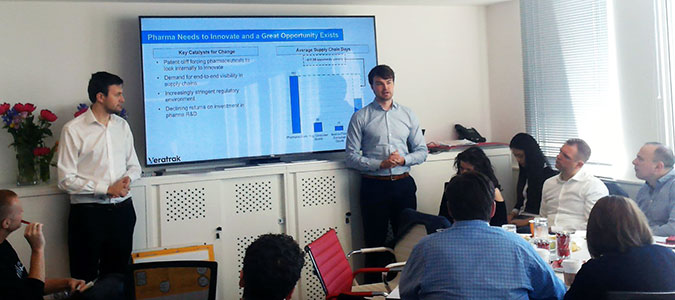Reflections on Innovation within the pharmaceutical supply chain

Last week, Veratrak CEO, Jason Lacombe and Head of Product, Matthew Wilson attended a day long workshop focused on “innovation” within pharmaceutical manufacturing and supply chain at the Big Innovation Centre in London.
On hand for the day was the senior management team of a large pharmaceutical company and a selection of invited technology companies and innovators from around the world. The theme was: ‘What will the pharmaceutical supply chain look like in 2030?’
Veratrak was invited as a result of being awarded “Innovation of the Year” by the University of Oxford for our blockchain based documentation sharing and collaboration platform for the pharmaceutical supply chain. The key takeaways from the workshop are discussed below.
Big Pharma thinks ‘big bang’, but the transition does not become anybody’s ownership using this approach. Incremental change is better, affecting the people in the organisation who gain ownership of this issues. This drives more success. Being agile is not about IT, but culture, business structure and rules.Professor Birgitte Andersen, CEO at the Big Innovation Centre
Traditional challenges for innovation and a changing tide
Large organisations have been slow to adopt new and disruptive technologies, however changing market conditions within the pharmaceutical industry are now making this a very exciting time for innovation.
Patent cliff – 92% of prescription medicines will become generic by 2020*
Traditionally the pharmaceutical industry has relied upon high margin patented drugs, with cost optimisation being seen as less important. This is no longer the case, with senior management at pharmaceutical companies looking to decrease cost and improve efficiency in the supply chain.
Increasing regulations – more than 40 countries have introduced track and trace laws**
Serialisation requirements such as the EU Falsified Medicines Directive and the US Drug Supply Chain Security Act have forced pharmaceutical companies and their downstream supply chain partners to begin to digitise. Additionally, companies are beginning to look at the value that a digitised supply chain can offer beyond compliance, such as using technology to increase supplier collaboration and visibility and end to end traceability. There is a large opportunity for supply chain departments to drive down costs and decrease working capital by taking on new tools following serialisation projects.
Personalised Medicine – 73% of oncology drugs in development currently are personalised***
The increasing development of personalised medicines will require much shorter supply chains. No matter how effective and innovative the drug, if it takes 6 months to be manufactured and shipped, patients’ won’t see the benefits. Current proposals include unsustainable ideas such as flying cancer patients internationally to manufacturing sites. This indicates the scale of challenge seen by pharmaceutical companies in decreasing the average supply chain days.
Another large challenge with personalised medicines is the integrity of chain of custody. Samples harvested from a patient must travel halfway across the globe for medicines to be manufactured with those medicines then flowing back to the patient. Current methods do not give a sufficient level of assurance that patients will receive the correct drug.
Challenges for the enterprise vs startups
An interesting topic discussed was about how Veratrak and the other smaller businesses encourage and drive innovation internally and the different challenges faced to those at larger companies.
There are a number of reasons why we believe, smaller, younger companies find an innovation culture easier to build and maintain:
Alignment. The size of teams in small business allows for levels of transparency and communication that is near impossible in larger companies. This, combined with the excitement and drive to create and scale, permeates through the entire organisation, ensuring that all are pulling in the same direction.
The consequences of not innovating. For young companies, not innovating means going out of business quickly. The consequences of not innovating for large companies are just as disastrous, but the speed of death is much slower, reducing urgency for both the business and for individuals. As the large corporate becomes marginally less competitive with their market offering, it is death by a thousand cuts.
Self selection. As startup companies tend to be founded around an innovation, it is hardly surprising that these companies have a more innovative culture and value innovation highly. This is compounded due to the experience and mindset of the types of people who forgo increased job security and structure to work for a growing but higher risk company.
Innovation as a new way of life
Reflecting on the changing landscape of the pharmaceutical industry, there is an increasing need for innovation within manufacturing and supply chain. There are challenges in building a culture of innovation for large companies, and these must be understood and countered.
Clarity of vision must be owned from both the top-down and bottom-up. Leaders used to think in financial terms but now they need to think survival and vision. A shared vision for the future is important. When this happens, everything will follow.Professor Birgitte Andersen CEO at the Big Innovation Centre
Tips on innovation for pharmaceutical companies:
Top down and bottom up. Innovation must form part of a long-term strategy with the correct incentive and funding structure being put in place to allow appropriate risks to be taken by management. It also needs to come from within, listening to those throughout the organisation can be a great source of inspiration and, without universal buy in, new tools and processes will struggle to succeed. As noted, this is where smaller companies have an unfair advantage in the ability to communicate and get buy in from the whole organisation.
Think big, start small. For any given initiative there needs to be a vision and long-term plan, however talk and plans without action will not be useful. Technology moves quickly, and this needs to be reflected in the ability to make decisions quickly. A fail/learn fast approach of starting with small arenas for new innovations and iteratively rolling them out mitigates risk and ultimately delivers better results.
Partner and co-innovate. Look to work closely and partner with software providers and other innovators. These relationships can be symbiotic in many ways. Organisational cultural exchange and learnings can be valuable. This partnership approach is also vital for working in the agile, iterative approach discussed above, with high quality feedback and information flowing both ways.

Citations*
https://s3.amazonaws.com/assets.fiercemarkets.net/public/005-LifeSciences/imsglobalreport.pdf** https://www.pharmpro.com/article/2017/11/global-pharma-market-increases-need-track-and-trace*** https://www.statista.com/statistics/688327/personalized-medicines-in-development-by-type/
